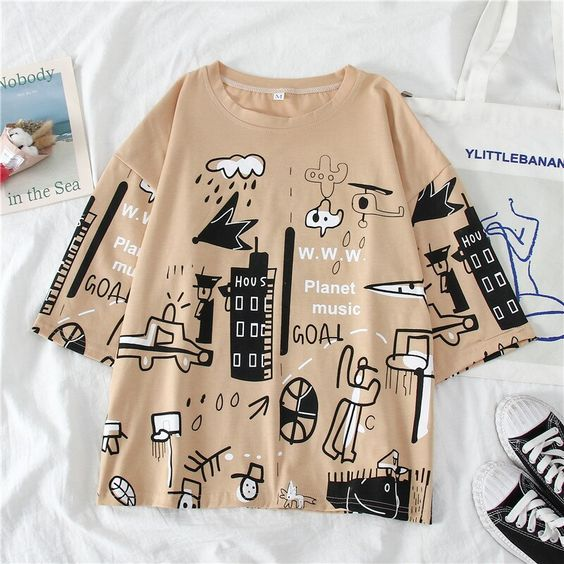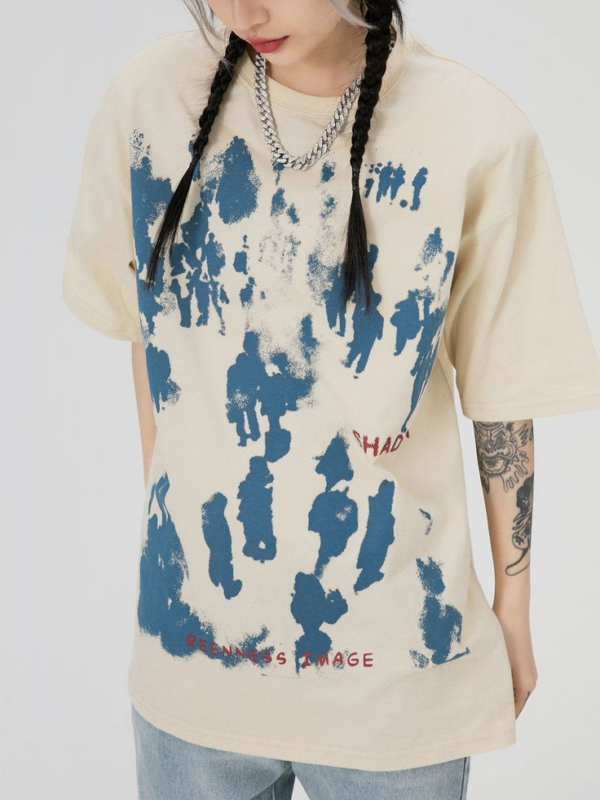Sleeves are a prominent print location that is often overlooked. Whether it’s a tailored or on-trend T-shirt, T-shirt sleeve design printing or printed patterns is ideal for conveying a range of brand messages. T-shirt sleeve printing logo is the most common. This article explains why you should print designs on t-shirt sleeves and how to print them. Check out TOB wholesale, which has a variety of T-shirt designs. If you run a T-shirt clothing store, it is undoubtedly one of the best wholesalers.
What Is T-shirt Design Printing?
T-shirt printing is an easy and inexpensive way to get a custom design or logo printed on a T-shirt. T-shirt printing can be done in multiple areas including sleeves, front, back and more. You can also remove print designs on t-shirt according to your preference. There are many reasons why T-shirts are printed on the sleeves. It can reflect the wearer’s style or specific information, suitable for team customization, and can also be used to promote your own brand and enhance your influence.
T-shirt printing can use a variety of printing techniques, such as digital and screen printing , direct-to-garment printing, and dye-sublimation printing, which can apply logos, visual styles, and other artwork to T-shirts. T-shirt print designs can also contain intricate designs, text or images. Whether you want to design your own new fashion label or create a memorable t-shirt print for a specific event, there are many unique options to help you achieve your goals.

This content is sourced from Wikipedia: View more
Why Is The Print Designs On T-shirt Sleeves?
Printing a design on a T-shirt sleeve can have several advantages over other locations on the shirt. Here are some reasons why a designer or brand might choose to print on the sleeve:
Unique design: T-shirt sleeves are the prominent part of the shirt, and T-Shirts featuring Graphic Prints on the sleeves can add visual interest and become a focal point. This works especially well if the design is bold, colorful or complex.
Visual interest: Sleeves are a prominent part of the shirt, and printing a design on them can add visual interest and create a focal point. This can be particularly effective if the design is bold, colorful, or intricate.
Branding: If a company or brand wants to promote its logo or message, having its logo design printed on a t-shirt sleeve is a great option. A sleeve is a visible location that catches the eye and helps build brand awareness.
Subtlety: In some cases, a print on the sleeve of a t-shirt can be a more subtle way of incorporating a design or message into a garment. This is especially effective if the brand or message is not intended to be in focus but still needs to be conveyed.

The Way Of T-shirt Sleeve Printing
There are many printing methods for T-shirt sleeves, each presenting a different visual effect and suitable for different situations. Each printing method also has its own advantages and disadvantages.
- Screen printing
Screen printing is a printing technique that involves pressing ink through a mesh screen onto a surface, usually a T-shirt or paper. The screen is stretched tightly over the frame, and the stencil is formed by masking areas of the screen with stencil material, leaving open areas through which ink can pass. To print a design, ink is poured onto one end of the screen and spread across it with a squeegee, pushing the ink through the open areas of the stencil and onto the surface below.
When printing the design on the t-shirt sleeves, repeat the process for each color in the design, creating separate screens and templates for each color. Screen printing is versatile and durable, producing vibrant, high-quality prints on a variety of surfaces.

- Heat Transfer Printing
Thermal transfer is another printing technique that involves using heat and pressure to transfer a design or image from T-shirt transfer paper or film to a substrate such as a T-shirt or other fabric.
The process begins by printing the design onto a special transfer paper or film, which is then placed face-down on a substrate. Use a heat press or similar device to apply heat and pressure to the transfer paper to transfer the ink from the paper to the fabric.
This approach works well for small designs and those that require multiple colors. They can be in full color and are great for preserving precise details. The downside is that printed labels or images can easily fade or become dirty over time, especially if they are exposed to heat or sunlight. Also, it has limited material compatibility and may not work with some materials.

- Direct-to-garment printing
Direct-to-garment (DTG) printing technology prints digital images directly onto T-shirt sleeves. It is a popular alternative to traditional screen printing.
DTG printing involves a specialized printer that sprays ink onto fabric using a precise nozzle system. The ink is absorbed into the fabric and dries quickly, resulting in a high-quality, detailed print that is long-lasting and won’t crack or fade over time.
DTG printing is ideal for producing small quantities of custom garments quickly and economically, and is often used to print designs featuring multiple colors or photographic images. It’s also a popular choice for print-on-demand designs, since there’s no need to produce a lot of pre-printed garments.

Conclusion
If you want to showcase a perfect design on a T-shirt sleeve, you can choose a printing method according to your own needs. At the same time, be careful and safe during the printing process. You can practice simulation before printing to achieve the best printing results. Log in to TOB wholesale Website, and follow for more fashionable patterned T-shirts. You will find the products you want.
FAQs
What is the thing you use to print designs on t-shirts?
The thing used for printing designs on T-shirts is usually called a “screen printing machine” or “silkscreen printing machine”. Silkscreen printing is a popular method for printing designs on T-shirts, which involves pressing ink onto the fabric of the T-shirt through a template or mesh screen. This process can produce high-quality and durable prints that can withstand multiple washes and wears. There are other methods for printing designs on T-shirts, such as heat transfer printing and direct-to-garment printing, but silkscreen printing is one of the most common and widely used methods.
How do you screen print on sleeves?
Here is a step-by-step guide on how to do screen printing on sleeves:
- Choose the right equipment and materials
- Prepare the screen
- Set up the printing machine
- Load the ink
- Print on the sleeve
- Dry the print
Repeat this process if you need to print on the other side of the sleeve, using a new screen.
What is easiest way to print shirt designs?
There are several methods for designing printed shirts, and the simplest method depends on the specific content of the design and available resources. Here are a few options:
- Heat transfer paper: This is a relatively simple and cost-effective method for printing designs on shirts.
- Screen printing: This method can produce high-quality prints that last a long time, but it requires more equipment and expertise than heat transfer paper.
- Direct printing on the garment: This method can produce high-quality prints with a lot of detail, but it may be expensive and time-consuming. Ultimately, the easiest method for printing shirt designs will depend on your specific needs and resources.


